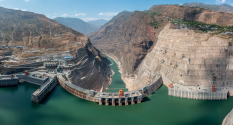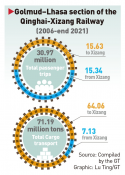You are using an out of date browser. It may not display this or other websites correctly.
You should upgrade or use an alternative browser.
You should upgrade or use an alternative browser.
China News Thread
- Thread starter KYli
- Start date
KUNMING, May 21 (Xinhua) -- All power-generating units of the Baihetan hydropower station in southwest China have been constructed, marking a major step toward the full operations of the mega project, according to the hydropower station.
All units are due to be operational by the end of the year. Baihetan will then be the world's second-largest hydropower station in terms of total installed capacity, second only to the Three Gorges Dam project in the central Chinese province of Hubei.
The hydropower station is located on the Jinsha River, the upper section of the Yangtze River in southwest China. It straddles the provinces of Yunnan and Sichuan.
Baihetan will have a total installed capacity of 16 million kilowatts. It is equipped with 16 hydro-generating units, each with a capacity of 1 million kilowatts, the largest single-unit capacity in the world.

All units are due to be operational by the end of the year. Baihetan will then be the world's second-largest hydropower station in terms of total installed capacity, second only to the Three Gorges Dam project in the central Chinese province of Hubei.
The hydropower station is located on the Jinsha River, the upper section of the Yangtze River in southwest China. It straddles the provinces of Yunnan and Sichuan.
Baihetan will have a total installed capacity of 16 million kilowatts. It is equipped with 16 hydro-generating units, each with a capacity of 1 million kilowatts, the largest single-unit capacity in the world.

The China National Offshore Oil Corporation (CNOOC), the country's leading liquefied natural gas (LNG) supplier, said on Tuesday it had completed the vault hoisting of the world's largest LNG storage tanks in Yancheng City in east China's Jiangsu Province.
The six giant tanks with a capacity of 270,000 cubic meters are designed and developed solely by China. Upon completion, each storage tank will be 60 meters high, equivalent to the height of the National Stadium (or the Bird's Nest) and can accommodate three Boeing 747 aircraft simultaneously.
The vault is an important component of an LNG storage tank, equivalent to the "beam" of the LNG storage tank. The single vault spans nearly 100 meters and consists of one central ring and 24 large and small vault modules. The maximum span of the vault module is 46 meters, with the single piece weighing 33 tonnes.
"After completing the vault hoisting operation, we will start the welding of the vault and concrete placement of the tanks immediately, laying a foundation of follow-up steps. The CNOOC is a world leader in the independent design and construction of ultra-large LNG storage tanks," Yuan Bin, deputy manager of the Yancheng LNG project of CNOOC, told China Media Group.
A key part of China's plan for a natural gas production, supply, storage, marketing and connectivity system, the project will be put into operation in December 2023 with an annual LNG processing capacity of 5.44 million tonnes, reducing carbon dioxide emissions by 17.07 million tonnes and nitrogen oxides by 302,999 tonnes.
The six giant tanks with a capacity of 270,000 cubic meters are designed and developed solely by China. Upon completion, each storage tank will be 60 meters high, equivalent to the height of the National Stadium (or the Bird's Nest) and can accommodate three Boeing 747 aircraft simultaneously.
The vault is an important component of an LNG storage tank, equivalent to the "beam" of the LNG storage tank. The single vault spans nearly 100 meters and consists of one central ring and 24 large and small vault modules. The maximum span of the vault module is 46 meters, with the single piece weighing 33 tonnes.
"After completing the vault hoisting operation, we will start the welding of the vault and concrete placement of the tanks immediately, laying a foundation of follow-up steps. The CNOOC is a world leader in the independent design and construction of ultra-large LNG storage tanks," Yuan Bin, deputy manager of the Yancheng LNG project of CNOOC, told China Media Group.
A key part of China's plan for a natural gas production, supply, storage, marketing and connectivity system, the project will be put into operation in December 2023 with an annual LNG processing capacity of 5.44 million tonnes, reducing carbon dioxide emissions by 17.07 million tonnes and nitrogen oxides by 302,999 tonnes.
China to electrify section of Qinghai-Xizang railway
China will electrify the Golmud-Lhasa section of the Qinghai-Xizang Railway, the world's highest, longest and fastest plateau railway, starting in June with a total investment of 14.84 billion yuan ($2.22 billion), in a major step to improve the crucial railway's efficiency.
The project is expected to be completed within three years and the investment in the Xizang section will be 7.21 billion yuan, according to a report on local news outlet xzxw.com's official Wechat on Saturday.
The plan will enhance the transportation capacity and service quality of the railway, while lowering costs and improving safety, reliability and risk resistance, which will support China's carbon peaking and carbon neutrality goals, said the report.
The turnout replacement and signal system transformation for the section, a sub-project of the electrification, is going through the bidding process and other procedures, with construction set to start in late June.
The length of the Golmud-Lhasa section is 1,136 kilometers. Upgrading of passenger facilities in the Anduo, Naqu and Dangxiong stations will also be undertaken.
Analysts said that the transformation will play an indispensable role in the economic and social development of areas along the section of the line, as the transportation efficiency will be increased, and the transformation will help promote the development of clean energy and protect the environment of the Qinghai-Xizang Plateau.
Xiong Kunxin, a professor at the Minzu University of China, told the Global Times on Sunday that the project will improve the logistics system in the area and promote connections with other provinces. Economic development will also get a boost, especially for industries like tourism.
Data showed that as of the end of 2021, the Lhasa station had handled 30.97 million passenger trips and 71.19 million tons of cargo to and from Xizang since 2006, when the section was opened as the only railway transport channel connecting the region with other provinces.
Electrifying the line will make the trains more efficient, as the electric locomotives will have more traction on the Xizang Plateau than the current internal combustion locomotives, and they will reduce pollution, Zhao Jian, a professor at Beijing Jiaotong University, told the Global Times.

China will electrify the Golmud-Lhasa section of the Qinghai-Xizang Railway, the world's highest, longest and fastest plateau railway, starting in June with a total investment of 14.84 billion yuan ($2.22 billion), in a major step to improve the crucial railway's efficiency.
The project is expected to be completed within three years and the investment in the Xizang section will be 7.21 billion yuan, according to a report on local news outlet xzxw.com's official Wechat on Saturday.
The plan will enhance the transportation capacity and service quality of the railway, while lowering costs and improving safety, reliability and risk resistance, which will support China's carbon peaking and carbon neutrality goals, said the report.
The turnout replacement and signal system transformation for the section, a sub-project of the electrification, is going through the bidding process and other procedures, with construction set to start in late June.
The length of the Golmud-Lhasa section is 1,136 kilometers. Upgrading of passenger facilities in the Anduo, Naqu and Dangxiong stations will also be undertaken.
Analysts said that the transformation will play an indispensable role in the economic and social development of areas along the section of the line, as the transportation efficiency will be increased, and the transformation will help promote the development of clean energy and protect the environment of the Qinghai-Xizang Plateau.
Xiong Kunxin, a professor at the Minzu University of China, told the Global Times on Sunday that the project will improve the logistics system in the area and promote connections with other provinces. Economic development will also get a boost, especially for industries like tourism.
Data showed that as of the end of 2021, the Lhasa station had handled 30.97 million passenger trips and 71.19 million tons of cargo to and from Xizang since 2006, when the section was opened as the only railway transport channel connecting the region with other provinces.
Electrifying the line will make the trains more efficient, as the electric locomotives will have more traction on the Xizang Plateau than the current internal combustion locomotives, and they will reduce pollution, Zhao Jian, a professor at Beijing Jiaotong University, told the Global Times.

Sad cases for thousands of parents daughters being kidnapped years ago and are still hopeful to see them return.
Plan is to build 50 of these 130,000 tonners for an annual output of 200,000 tonnes -
While it may seem impressive at face value, it's still a far cry from the 15 million tonnes China catches annually.
If there's ever any plan or intention to alleviate overfishing, even at a 30% reduction i.e. 4.5 million tonnes i.e. what Japan alone hauls in annually, they'd need at least a thousand of these boats just to achieve that.
Then again, I'm quite certain the purpose of this project is not to combat overfishing per se, but to reduce near-shore/coastal farming, which pollutes nearby environments, by bringing the farming out to sea.
That and the ability to breed and farm higher quality high seas fish species like tuna and salmon due to access to practically limitless clean seawater, I reckon.

Many places across China have launched a new round of saline-alkali tolerant rice - or better known as "seawater rice" - transplanting this week, aiming to increase output as the country strives to ensure food security amid an increasingly uncertain global food market.
The domestic planting area of "seawater rice" surpassed 600,000 mu (40,000 hectares) by the end of 2021, and it is projected to exceed 1 million mu in 2022, the Qingdao Saline-Alkali Tolerant Rice Research and Development Center told the Global Times on Sunday.
"China has 1.5 billion mu of saline-alkali soil and 3 million mu can be improved," Wan Jili, director of the technology R&D department of the center, told the Global Times on Monday. She noted that the goal of improving 1 million mu of saline-alkali soil in 2022 will be a milestone.
Current planting areas for saline-alkali tolerant rice are distributed among seven provinces, including Northwest China's Xinjiang Uygur Autonomous Region, East China's Zhejiang and Jiangsu provinces, and Northeast China's Heilongjiang and Liaoning provinces.
Qingdao in East China's Shandong Province on Sunday kicked off the fifth transplanting festival for saline-alkali tolerant rice. North China's Inner Mongolia Autonomous Region, the Xinjiang Uygur Autonomous Region, Heilongjiang Province and Zhejiang Province also kicked off the annual transplanting at the same time.
"The species of rice we are transplanting can grow in saline water with concentrations of eight per 1,000, and its output per mu can reach about 450 kilograms, about half of the regular rice output," Wan noted. She said even though the output of saline-alkali tolerant rice is low, it is better than having nothing produced from "wasted" land.
Rice is one of the most important grain crops for Chinese people, so its output draws attention from agricultural authorities, Jiao Shanwei, editor-in-chief of industry news website cngrain.com, told the Global Times on Monday.
"China can produce about 200 million tons of rice each year at present if there are no large-scale natural disasters, and rice is slightly oversupplied in the market," he noted, adding that some countries have tightened grain exports, but their measures can hardly affect China's grain security, especially for rice.
Developed by China's "Father of Hybrid Rice" — the late Yuan Longping, the "seawater rice" is a major breakthrough in China's efforts to expand rice output.
On May 28, 2018, Yuan initiated the first transplanting festival for saline-alkali tolerant rice. After Yuan died on May 22, 2021, the Qingdao Saline-Alkali Tolerant Rice Research and Development Center, one of the places where he worked, changed the date of the festival to May 22 in order to commemorate the renowned agricultural researcher.
"Yuan's goal was to improve 100 million mu of wasted soil by planting saline-alkali tolerant rice, which means adding 100 million mu of cultivated land for the country — a noble ideal," Wan noted.
It seems like that some young people in Xinjiang aren't too keen on population expansion.
